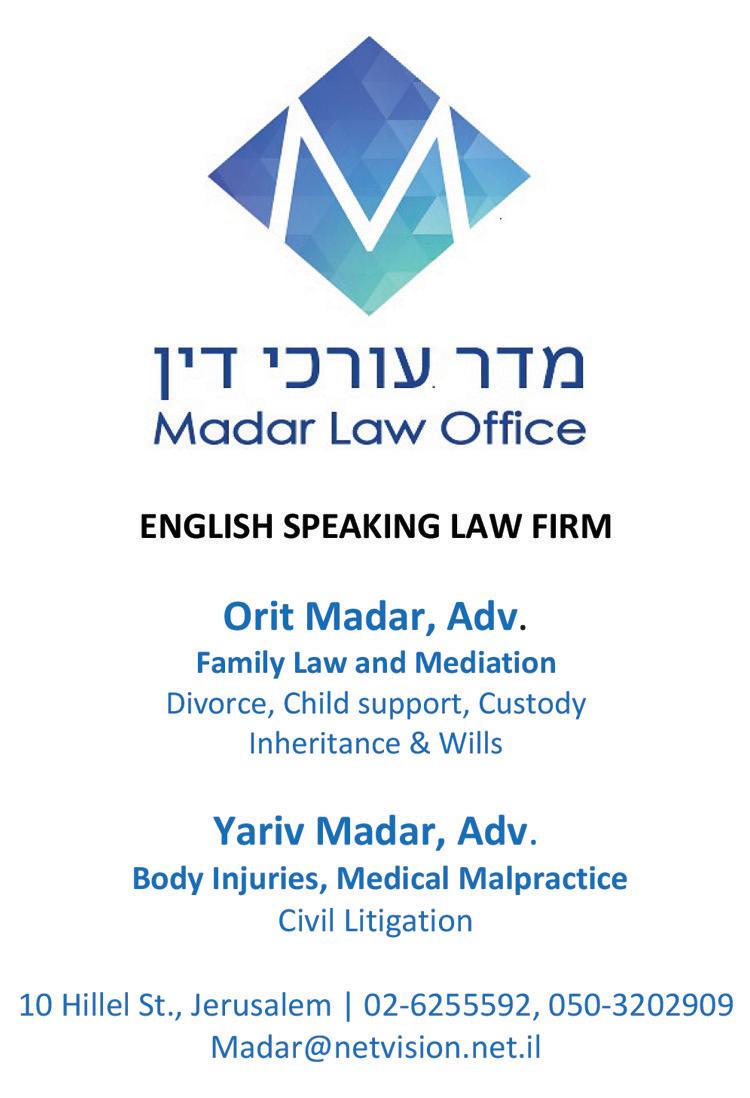
16 minute read
The Prohibition Of Uprooting Fruit Trees Part 2 Rabbi Moshe Bloom
INSTITUTE
BY RABBI MOSHE BLOOM www.toraland.org.il/en
Advertisement
The Prohibition Of Uprooting Fruit Trees – Bal Tashchit #2
Last week we started the halachot about uprooting fruit trees. Some poskim maintain that even when it is technically permissible to uproot a fruit tree, one should avoid doing so since it is spiritually harmful. One should especially refrain from uprooting such trees when there is a doubt regarding the prohibition of bal tashchit. Other poskim contend that once it is halachically permissible to uproot a tree, one need not be concerned about spiritual harm.
If one wants to build a home and a fruit tree is in the way, some poskim permit uprooting the tree. Others permit it providing that it is to allow the person to build a house for one’s basic needs, but not to expand one’s living quarters. Others contend that even if one needs the land the tree is sitting on, it is nevertheless forbidden to uproot a fruit tree.
Some poskim maintain that it is permissible to uproot a fruit tree together with the clod of dirt surrounding its roots that is large enough to nourish the tree, and then transplant it elsewhere. Others disagree.
In cases of doubt: (1) when there is a disagreement among the poskim or (2) if it isn’t clear whether the yield of the tree is sufficiently insubstantial to justify uprooting it, it is best to commission a non-Jew to uproot the tree. The tree should be uprooted together with the clod of dirt encasing its roots, large enough to nourish it. Subsequently, the tree should be transplanted to another location.




WEIN
Rav, Beit Knesset Hanassi, Jerusalem
One of the greatest problems that has dogged religious life throughout the centuries is the place of material wealth and money in the structure of religious life. It is obvious to all that wealth and money corrupt and sully noble programs and plans.
The question boils down to the old and eternal issue as to whether the noble end - Jewish education, synagogue worship, social charitable endeavors -- justify the means, i.e. the means often border on the unethical of procurement of money to achieve these noble ends. Monetary scandals have plagued all religious projects and ambitions from time immemorial. The fact that the goal trying to be achieved is so noble and so morally necessary, makes the temptation to deviate from correct probity and proper behavior in fundraising and monetary conduct all the more tempting.
Unfortunately, the history of religion is littered with monetary scandal and money - driven by poor decisions. The prophets of Israel decried this situation during First Temple times, but apparently to little avail. Religion sadly has a tendency

to transform itself into a business, a commercial enterprise. And this always leads to desecration of God’s name and catastrophic disasters.
Many commentaries and scholars have stated that this monetary corruption was the real basis for the destruction of the Temples themselves, and the continued cessation of Temple service even until our very day. Even buildings and programs conceived in holiness and founded by the most righteous of people are susceptible over time to fall into the trap of monetary scandal. I need not and will not enumerate specific examples of this weakness, but all of us are well aware of their existence and sad influence.
Yet, in spite of all of this, these dangers are almost inevitable. This week’s Torah reading combines the ideas of holy service to God with the necessity of fundraising and material wealth. The Torah apparently is of the opinion that the benefits of channeling and using money for noble good outweighs the dangers inherent in combining religion with wealth and money. In fact, this is the pattern of the
Acupuncture and Chinese Medicine Yael Tusk, M.Sc. Infection·Pain·Menopause·Respiratory· Bowel Disease and more 052-768-4438 15+ YEARS www.Yaeltusk.com
Torah in all matters of everyday life events and society. Judaism does not allow for excess ascetism or hermit-like lifestyles.
We are always somehow to be engaged in this world, tawdry and flawed as it may be. Yet the challenge is to somehow remain a holy people, a kingdom of priests, while dealing with these challenges that mark our daily lives and society. The holy tabernacle/mishkan is to be constructed through human donative intent and through heartfelt donations of material wealth and personal volunteerism. Religion and faith are corrupted by wealth. But wealth applied correctly and through a generous hand can enhance and even ennoble religion. Moshe was shown in Heaven a coin of fire. It can burn and destroy. It can warm and light the way. The word T'rumah itself in its literal sense means to uplift and raise. Wealth properly used and applied can be the engine that propels all holy endeavors forward. As it was in the time of Moshe, so, too, does it remain one of the greatest challenges in Jewish life.
Shabbat shalom!


HALACHA
BY RABBI SHIMSHON HAKOHEN NADEL Mara D'atra, Kehilat Zichron Yosef, Har Nof OU Israel Faculty
Is It A Mitzvah To Vote?
Voter turnout for Israel's first elections in 1949 was 86.9%, but recent years have seen a significant decline. This past April, only 68.5% of those eligible voted, and in September's elections only 69.8% of Israelis cast their ballots. With so many crucial issues hanging in the balance - national security, economic stability, and education, to name just a few - it is surprising more Israelis don't participate in the elections.
But is it a Mitzvah to vote?
The story is told that a man once approached Rav Avraham Yeshaya Karelitz, the revered Chazon Ish, and explained that he did not have enough money to pay his taxes and would not be allowed to vote in the upcoming elections. The Chazon Ish asked the man if he owns a pair of Tefillin. The man replied, "Of course." The Chazon Ish then instructed the man to sell his Tefillin and pay his outstanding taxes so he would be allowed to vote. The Chazon Ish explained, "You
can borrow Tefillin from someone else, but you can't borrow your right to vote from someone else!”
While this story may sound extreme, according to many authorities it is indeed a mitzvah to vote.
The Torah commands: "You shall surely set over yourself a king whom Hashem, your G-d, shall choose..." (Devarim 17:15). In fact, according to the Rambam, appointing a king is one of three mitzvot to be fulfilled upon entering the Land of Israel (Hilchot Melachim 1:1; Sefer Hamitzvot, Aseh 173. See also Sanhedrin 20b; Sifrei, Re'eh).
But what about electing a body to govern the modern State of Israel?
In a Teshuvah written to Rav Shlomo Zalman Pines in 1916, Rav Avraham Yitzchak Kook defends the creation of a modern democratic state in Israel, even without a king or Sanhedrin (Mishpat Kohen 144).
Rav Kook argues that in the absence of a Sanhedrin or a prophet, a king can be appointed by “consent of the Jewish Nation.” Rav Kook continues, “When there is no king, since the laws of government concern the general welfare of the Nation, the rights of government return to the Nation" (See Radbaz to Radbaz to Hilchot
According to Rav Kook, the Jewish People have the right to self-determination and have the authority to create a government at all times. He goes as far as saying that “any lawmaker that arises in Israel has the status of king concerning governing the state.” He cites the Rambam (Hilchot Sanhedrin 4:13), who rules that the Reish Galuta (Exilarch) in Babylonia had the status of king, and writes, “all the more so when there are leaders chosen by the Nation when she is in her sovereign land.”
Based on the above, it would appear that according to Rav Kook electing a body to govern the Jewish Nation is indeed a fulfillment of the mitzvah to appoint a king. (See also Rav Shaul Yisraeli, Amud Hayemini 7).
In addition, the Torah (Devarim 16:18) instructs us to "appoint judges and officers in all of your cities," establishing a just and equitable society. This mitzvah includes creating a central supreme court and local district courts, as well as appointing officers to enforce the law. Without a government, there would be total anarchy. The Mishnah (Avot 3:2) states: “Rabbi Chanina, deputy High Priest, said: Pray for the welfare of the government, for were it not for fear of it, people would swallow one another alive." A democratically elected government ensures that no one "swallow one another alive."
life. Many pages in the Talmud discuss the responsibility members of a community have to their community and to one another. The Talmud also describes the responsibilities that officials have to their community, and even the process of electing community leaders and the need for consensus. Rav Yitzchak, for example, taught: "One may not appoint a leader over the community unless it is by consent of the community" (Berachot 55a). In fact, all decisions concerning the community require a consensus and the support of a majority (Rema, Choshen Mishpat 163:1).
According to the Rashbah, the leaders of a community need not be the wisest sages, but rather the individuals that a community elects to govern them. And those elected leaders have significant authority over the community (See Rema, Choshen Mishpat 2:1).
On October 3, 1984, Rav Moshe Feinstein penned a letter encouraging the Jewish community to vote in the upcoming US Presidential Elections. Rav Moshe wrote: "A fundamental principle of Judaism is hakaras hatov — recognizing benefits afforded us and giving expression to our appreciation. Therefore, it is incumbent on each Jewish citizen to participate in the democratic system which guards the freedoms we enjoy. The most fundamental responsibility incumbent on each individual is to register and to vote.
Therefore, I urge all members of the Jewish community to fulfill their obligations by registering as soon as possible, and by voting. By this, we can express our appreciation and contribute to the continued security of our community.”
If Rav Moshe felt that a citizen of the United States is obligated to perform his/ her civic duty and vote, all the more in Israel, especially with all that is at stake.
And while the "heart of the King is in the Hand of Hashem" (Mishlei 21:1), it is in our hands to choose our leaders.
Among the many contemporary authorities who rule that it is indeed a mitzvah to vote in Israel's elections are Rav Shmuel Eliyahu, Rav Shlomo Aviner, Rav Ratzon Arusi, and Rav David Stav.
Before the elections for the First Knesset in January 1949, a number of leading rabbis issued a ‘Kol Koreh,’ urging their flock to participate, and stating that it is indeed a “Mitzvah to vote!” The Belzer Rebbe, Rav Aharon Rokeach, was approached by one of his chassidim who asked, “Is it really a mitzvah? A mitzvah like eating Matza?” The Belzer Rebbe thought for a moment and quipped, “Maybe more like eating Maror!” (See Yosef Israel, Rescuing the Rebbe of Belz, p. 497).
For many frustrated Israelis, voting in a third round of elections feels like "eating Maror." But exercising our civic duty and participating in Israel's elections is both an obligation and an opportunity to build the Jewish State together, and ensure a bright future for our children and their children.


SPRECHER
Faculty, OU Israel Center
The Mishkan Altar– A Virtual Gan Eden
“Gd tells Moshe, you must make the Altar of hollow planks of wood…” (Shemot 27:8) This Altar was situated in the Courtyard, outside the Mishkan itself. This wooden Altar was a hollow structure that was filled up with earth each time the Mishkan was set up.
Why did Gd command that the Altar of Atonement should be filled up with earth? The Yerushalmi Nazir 7 and the Bereshis Rabba 14 state that Gd created Adam out of the very earth taken from the future sight of the Altar. What is the meaning of this profound teaching? The Lubavitcher Rebbe explains that the meaning is that Atonement and Tshuva is an intrinsic aspect of our DNA (Divine Natural Ability) going back to the first human being.

This insightful idea is also alluded to by the fact that the Altar was filled with ADAMA, for the name of the original human being, ADAM, also means Earth. Kabbalistically, just as humanity was formed from Altar-Earth, the Altar was constructed out of the very humanity for which it was built to atone.
Thus, when Adam was banished from Gan Eden, the Torah says that he was sent “to work the EARTH from which he was taken” (Bereshis 3:23). We cultivate the earth to grow the food that keeps us alive, to produce the clothing that protects our bodies, and to build the homes that shelter and protect us from harm.
When we do all this in order to devote ourselves to Torah and Mitzvot, we elevate and sanctify the earth. This is a way to rectify the sin of Adam and to return symbolically to Gan Eden.
BETWEEN YERUSHALAYIM AND CHEVRON
Experience and meet extraordinary places and people of this most special part of Eretz Yisroel. This is indeed a unique opportunity, especially in the fabulous early Spring season flowering magic! Thursday, March 12 Depart: Inbal hotel, 8:30 Return 5:30 220 shekels. shalompollack613@gmail.com
Janglo
MessageSearch Login Register
CITIES | BUSINESS DIRECTORY | JOBS | HOUSING | EVENTS | FOR SALE | JLIFE | RESTAURANTS | MORE... | ADVERTISE
BUILDING OR RENOVATING? Let Janglo Professionals do the work for you! CALL THEM NOW

HOME > ALUMINIUM
Aluminium 4 U Trissim/Windows/Doors/Screens 054-624-4000 Jerusalem
HOME > CURTAINS
CU Curtains & Upholstery 02-5337898 050-4173414 Jerusalem
HOME > ARCHITECTS HOME > PLUMBERS/ELECTRICIANS/HANDYMEN HOME > ALARM SYSTEMS Amy Cohn Architects 02-623 4420 Jerusalem I Secure - Security 052-6447780 Mevaseret Zion The Handymench Electrical 052-3427429 Jerusalem Yaakov Elharar - Kablan 050-714-9200 Jerusalem HOME > CONSTRUCTION & RENOVATIONS
HOME > PAINTERS HOME > APPLIANCES Avi & Itai - Painting 052-309-5353 / 052-4484702 Israel Ilan Ben Harosh Electrical Appliance Consultant 050-997-7788 Jerusalem
Build Smart Israel 052-9772219 Jerusalem HOME > CONSTRUCTION & RENOVATIONS
HOME > WATERPROOFING
Jacobs Projects Waterproofing & Mold Control 052-357-0000 Jerusalem
HOME > FURNITURE
Treemium - Furniture 052-275-5230 National
Yohanan Beeri - Architect 054-5878678 Jerusalem HOME > ELECTRICIANS
Upper-left are three coins - one of gold, one of silver, and one of copper/bronze - here representing the 3 precious metals that were collected for use in the construction of the Mishkan and its furnishings <> To the right of penny are two cabbages. In Hebrew - KRUV, as in the K'RUVIM (cherubs) on the KAPORET of the ARON <> Many of the other items in this ParshaPix represent the materials that were collected, and mentioned, in the beginning of the sedra <> The gemstone represents the stones for the CHOSHEN and the shoulder straps of the EIFOD <> The gold rings stand for the rings through which were inserted the carrying poles of some of the furnishings of the Mishkan <> And also, the rings that connected adjacent wallboards - even though those rings were rectangular rather than round <> The spools of thread represent the different colored wool and linen that were used to weave the coverings in the Mishkan. Also, to sew together the panels of the Mishkan and the Ohel <> Under the cabbages is a bouquet of flowers, in Hebrew - ZEIR. That is the term used in the Torah for the decorative border of gold that was made for the ARON and the SHULCHAN <> The olive oil represents the olive oil, which had several purposes in the service of the Mikdash. Remember that not only was olive oil used in the day-to-day service of the Mikdash (for the lighting of the Menora and as an ingredient in most Menachot), it was also used to consecrate each vessel <> Next to the olives is a tree and a log, standing (pun intended, as in Atzei Shitim Om'dim) for the ATZEI SHITIM, the acacia wood used extensively in the construction of the Mishkan <> Below the olive oil are representations of the three decorations of the Menorah. The trophy cup is called a GAVI'A. The computer key is KAFTOR and the flower is the PERACH. The actual Menora shapes did not necessarily resemble these, but the names match <> Then there is a sewing machine to facilitate various sewing jobs that were needed in the Mishkan. Remember, weaving was the main skill used to make the Mishkan (the first roof-like

covering), but the 10 panels of the Mishkan were sewn together, as were the 11 panels of the Ohel covering <> To the right of the sewing machine is a column or pillar, of which there were many in the Mishkan - to support the PAROCHET, the covering of the entrance of the Mishkan, the curtains of the courtyard, and the entrance to the courtyard. Many AMUDIM <> To the column's right and under the bouquet is a frame, MISGERET in Hebrew. The word is used in the description of the SHULCHAN <> In the frame is a mortarboard, graduation cap. It stands for the wisdom that G-d endowed Shlomo with (mentioned in the beginning of the haftara for T'ruma <> Matza with a face is LECHEM HAPANIM, which reminds us that those special loaves were halachic matza - not Chametz <> Notebook is MACHBERET, a term used in the sedra <> The computer screen is called a MASACH in Hebrew. The Biblical use of the word applied to the curtains that covered the entrance to the Mishkan and to the courtyard of the Mishkan <> Flag of Lebanon, reminding us of the Cedars of Lebanon mentioned in the Haftara <> An ax is GARZEN, mentioned in the haftara, the sound of which was not heard in the Temple area during construction... <> In the upper-right corner is our old friend, MUREX TRUNCULUS, the snail from which the T'CHELET and ARGAMAN dye for the Mishkan and garments of the Kohein Gadol (regular kohanim too, according to the opinion that their AVNEIT was also multi-colored) was and is extracted. This dye is used today by many people for the P'til T'cheilet of their tzitzit <> VI is 6 in Roman numerals. 6 is SHEISH, which also means linen in the context of Parshat T'ruma <> The B'SAMIM box represents the B'SAMIM that was collected for the anointing oil and the Ketoret <> The two good looking young fellows are grandson Dvir, which is one of the names for the Kodshei Kodashim. The other is grandson Shoham, as in the stones that were used for the EIFOD and the CHOSHEN. In addition, Shoham and his parents and younger sister live on Rechov Leshem (another stone of the Choshen) cor. Avnei HaChoshen, in Modi'in <> The optical illusion in the lower-right has a dot which either looks like it is inside or outside the box. The ARON was plated inside and out with gold <> Velcro represents the button & loop method of joining parts of the fabrics <> Rabbi Sholom Gold, dean of the Silver Jerusalem College for Adults - so he points to both Au & Ag <> and solve the new element between thread and sewing machine










